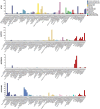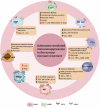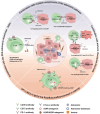The progress and prospects of targeting the adenosine pathway in cancer immunotherapy
- PMID: 40390144
- PMCID: PMC12090549
- DOI: 10.1186/s40364-025-00784-0
The progress and prospects of targeting the adenosine pathway in cancer immunotherapy
Abstract
Despite the notable success of cancer immunotherapy, its effectiveness is often limited in a significant proportion of patients, highlighting the need to explore alternative tumor immune evasion mechanisms. Adenosine, a key metabolite accumulating in hypoxic tumor regions, has emerged as a promising target in oncology. Inhibiting the adenosinergic pathway not only inhibits tumor progression but also holds potential to enhance immunotherapy outcomes. Multiple therapeutic strategies targeting this pathway are being explored, ranging from preclinical studies to clinical trials. This review examines the complex interactions between adenosine, its receptors, and the tumor microenvironment, proposing strategies to target the adenosinergic axis to boost anti-tumor immunity. It also evaluates early clinical data on pharmacological inhibitors of the adenosinergic pathway and discusses future directions for improving clinical responses.
Keywords: Adenosine; Adenosine receptors; CD39; CD73; Cancer immunotherapy; Tumor microenvironment.
© 2025. The Author(s).
Conflict of interest statement
Declarations. Ethics approval and consent to participate: Not applicable. Consent for publication: All authors approved the final version of the manuscript. Competing interests: The authors declare no competing interests.
Figures





Similar articles
-
CD39/CD73/A2AR pathway and cancer immunotherapy.Mol Cancer. 2023 Mar 2;22(1):44. doi: 10.1186/s12943-023-01733-x. Mol Cancer. 2023. PMID: 36859386 Free PMC article. Review.
-
Inhibition of the Adenosine Pathway to Potentiate Cancer Immunotherapy: Potential for Combinatorial Approaches.Annu Rev Med. 2021 Jan 27;72:331-348. doi: 10.1146/annurev-med-060619-023155. Epub 2020 Sep 9. Annu Rev Med. 2021. PMID: 32903139 Free PMC article. Review.
-
Inhibitors of the CD73-adenosinergic checkpoint as promising combinatory agents for conventional and advanced cancer immunotherapy.Front Immunol. 2023 Jun 26;14:1212209. doi: 10.3389/fimmu.2023.1212209. eCollection 2023. Front Immunol. 2023. PMID: 37435071 Free PMC article. Review.
-
Targeting adenosine for cancer immunotherapy.J Immunother Cancer. 2018 Jun 18;6(1):57. doi: 10.1186/s40425-018-0360-8. J Immunother Cancer. 2018. PMID: 29914571 Free PMC article. Review.
-
Adenosine in cancer immunotherapy: Taking off on a new plane.Biochim Biophys Acta Rev Cancer. 2023 Nov;1878(6):189005. doi: 10.1016/j.bbcan.2023.189005. Epub 2023 Oct 31. Biochim Biophys Acta Rev Cancer. 2023. PMID: 37913941 Review.
Cited by
-
Harnessing the interaction between redox signaling and senescence to restrain tumor drug resistance.Front Cell Dev Biol. 2025 Jul 9;13:1639772. doi: 10.3389/fcell.2025.1639772. eCollection 2025. Front Cell Dev Biol. 2025. PMID: 40703657 Free PMC article. Review.
-
Macrophages at the Crossroads of Chronic Stress and Cancer.Int J Mol Sci. 2025 Jul 16;26(14):6838. doi: 10.3390/ijms26146838. Int J Mol Sci. 2025. PMID: 40725081 Free PMC article. Review.
References
-
- Bruni D, Angell HK, Galon J. The immune contexture and Immunoscore in cancer prognosis and therapeutic efficacy [J]. Nat Rev Cancer. 2020;20(11):662–80. - PubMed
-
- Schreiber RD, Old LJ, Smyth MJ. Cancer immunoediting: integrating immunity’s roles in cancer suppression and promotion [J]. Science. 2011;331(6024):1565–70. - PubMed
-
- Baxevanis CN, Fortis SP, Perez SA. The balance between breast cancer and the immune system: Challenges for prognosis and clinical benefit from immunotherapies [J]. Semin Cancer Biol. 2021;72:76–89. - PubMed
-
- Woo SR, Corrales L, Gajewski TF. Innate immune recognition of cancer [J]. Annu Rev Immunol. 2015;33:445–74. - PubMed
Publication types
Grants and funding
- No. 2023M743967/fellowship of China Postdoctoral Science Foundation
- No. 2024JJ6684/Natural Science Foundation of Hunan Province
- No. 2023Q20/Youth Science Foundation of Xiangya Hospital
- No. kq2403025/Natural Science Foundation of Changsha
- No. 2022YFC2504700/National Key Research and Development Program of China
- No. 82130090/Key Program of National Natural Science Foundation of China
- No. 2023JJ10096/Science Fund for Distinguished Young Scholars of Hunan Province
- No. 2022RC1215/Science and Technology Innovation Program of Hunan Province
- U22A20329/key Program of National Natural Science Foundation of China
- 2023QYJC004/Central South University Research Programme of Advanced Interdisciplinary Studies
- No. 2023SK2095/the Scientific Research Program of FuRong Laboratory
LinkOut - more resources
Full Text Sources
Research Materials

